UZAY
Power Systems
GDÜB
(Power Regulation Unit)
TÜBİTAK UZAY develops Power Regulation Unit (PDRU) equipment for use in satellites and spacecraft within the scope of space research projects. The GCDU is the unit responsible for creating the main busbar and providing reliable energy for satellite/spacecraft loads under all foreseen conditions, without losing any function against environmental effects. While providing the regulation of the main busbar, GDÜB uses solar panels in daylight and batteries in darkness as energy sources. Within TÜBİTAK UZAY, two different GCDUs have been developed for 28V unregulated and 100V regulated busbar satellites and qualified according to MIL and ECSS standards. Thanks to their modular structure, these equipment can be modified to a power capacity of up to 9 kW for satellites with 100V regulated busbar and up to 2.4 kW for satellites with 28V unregulated busbar. The internal architecture of the equipment has a hot and cold redundant structure to prevent single point failure by ensuring reliability criteria. GDÜB successfully passed the electrical, engineering and flight model functional and environmental tests in the İMECE and TÜRKSAT-6A projects, and gained post-launch space qualification for both projects.
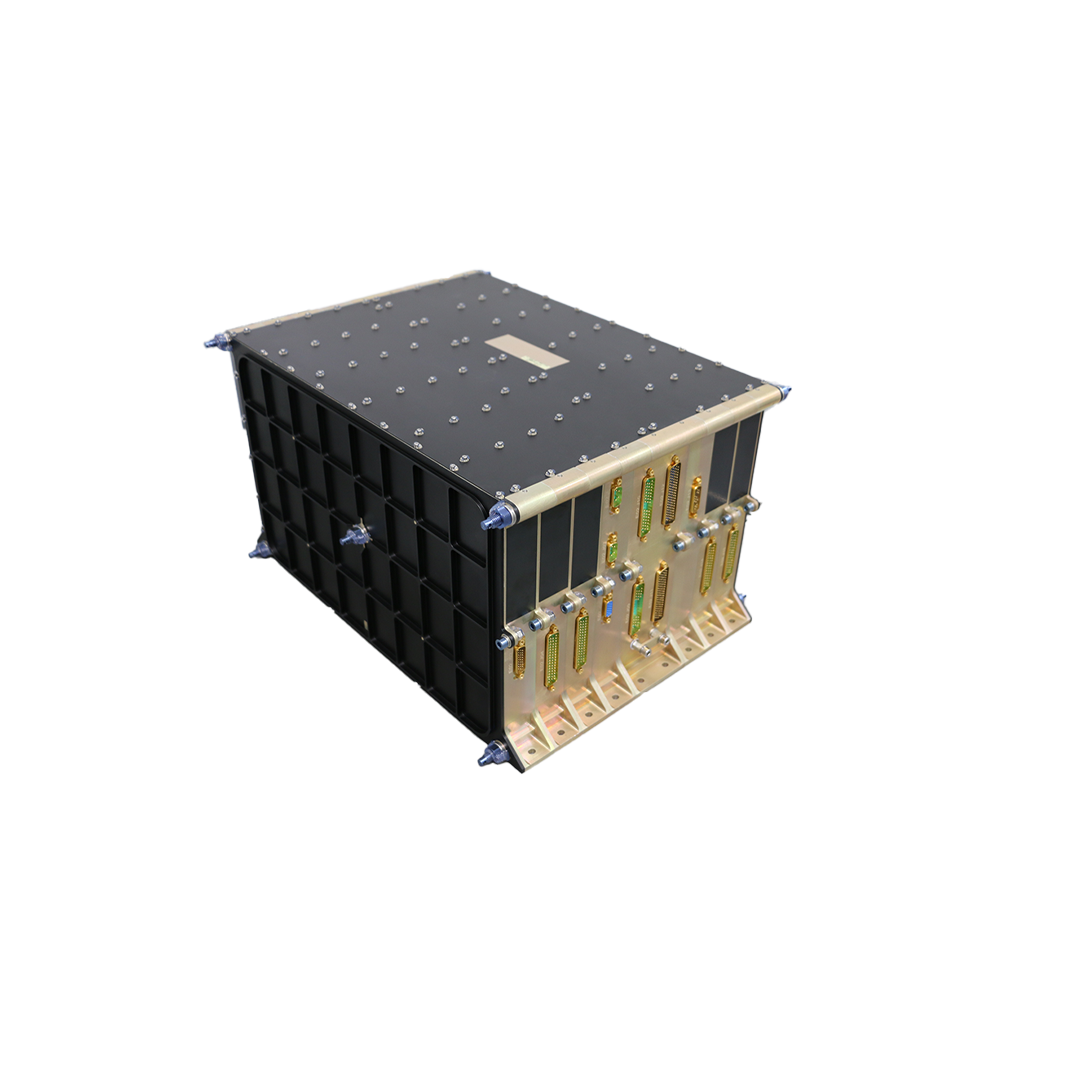
GDÜB 28V - IMECE
Power Regulation Unit 28V
Power Regulation Unit 28V is a qualified, fault tolerant and ready-to-use equipment developed by TÜBİTAK UZAY for LEO satellites within the scope of IMECE satellite. GDUB is to provide power to the 28 ±5 V unregulated main busbar of the satellite according to charge, end of charge and discharge modes. In charge mode, it converts the power from the solar panels to the satellite platform and directly to the battery through MPPT technique with a power capacity of 2.4 kW. In end of charge mode, it deactivates the MPPT to prevent the battery from overcharging. In discharge mode, it transfers the power required by the satellite platform directly from the battery.
Main Features
- Establishing a central low impedance point for the satellite platform.
- Combining solar panel and battery in a controlled manner with high efficiency MPPT.
- Direct connection to solar panels, batteries and satellite platforms without any interface requirements.
- Automatically realize charging, end-of-charge and discharge modes under its own control in all kinds of satellite conditions.
- Providing battery and solar panel telemetry (voltage, current, temperature) related to power management.
- Provide telemetry and telecommunications related to equipment management.
Budget
Mass: 20 ±0.5 kg @ 2.4 kW
Volume: 368 x 428 x 240 mm3 @ 2.4 kW
Power: up to 2.4k W at unregulated 28V bus bar
Interfaces
Main busbar: 28 ±5 V unregulated
Battery: Li-Ion
Primary power source: Solar panel
Data bus CAN bus
Environmental Conditions
- Thermal: -25°C to +50°C
- Radiation LEO (for 5 years)
- EMI/EMC: MIL-STD-461
- Vibration: 20 g (sine), 10 grms (random on Z axis) and 7 grms (random on X-Y axes)
- Shock: 40 to 1,200 g (0.1 to 10 kHz)
Use in Power Subsystem Scope
The 2.4 kW GDUB has 4 battery charge regulators (BCRs) to apply the MPPT technique to the solar panel power. Each PCR has a power capacity of 600W. The GDUB houses the internal power supply (IPS), Data Interface Unit (DAK), Capacitor Bank Uncoupling Switch Unit (CBU). LEO also has an Experimental Panel and Battery Interface Unit (DPPA) for testing up to 100W experimental panels and experimental batteries.
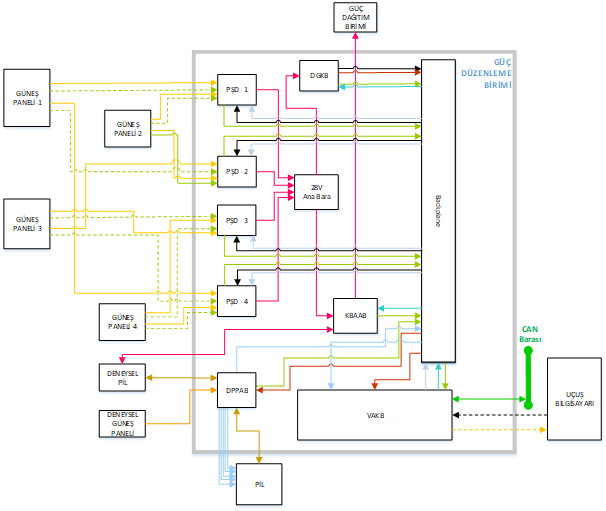
Performance
- Power output 2.4 kW (for 4 PCRs)
- Busbar voltage 28 ±5 V unregulated
- Throughput % 94 (full load at MPPT)
- Battery type: Li-Ion
- Battery charging current: 18 A (maximum)
- Battery mode: Charge, end of charge and discharge
- Battery management Automatic MPPT regulation
GDÜB 100V - TÜRKSAT 6A
Power Regulation Unit 100V
Power Regulation Unit 100V has been developed and qualified by TÜBİTAK UZAY for GEO satellites within the scope of TÜRKSAT 6A satellite, compatible with space conditions and fault tolerant. GDÜB 100V constitutes the 100±1V main power bus at the regulation point. The main bus is autonomously regulated by solar panel regulators and battery charge regulators during daylight hours, and by battery discharge regulators when the power generated by solar panels is insufficient for satellite loads and during eclipses. The residual power generated in the solar panels is used to charge the battery through 2 cold-redundant battery charge regulators when needed.
Main Features
- Main Bus Voltage : 100±1V
- Main Busbar Surge :
<0.4 Vp-p Daylight mode (Solar Panel Regulator)
< 0.1 Vp-p Retention mode (Battery Discharge Regulator) - Battery Charging Current : 0-10A (40 mA resolution)
- Battery Voltage Operating Range : 56V - 84V
- Battery Charge States : Constant current, constant voltage
- Daylight Power Capacity : 10 kW
- Discharge Power (Retention) :
9 kW (6 Battery discharge regulator operating state)
7.5 kW (1 Battery discharge regulator fault condition) - Power Converter Efficiencies :
Solar Panel Regulator >% 98.8 (@10 kW output power)
Battery Charge Regulator >% 93.1 (@10A and 58V to 84V Battery charge)
Battery Discharge Regulator >% 95.9 (@7.5kW output power @ 56 - 84 V Battery voltage) - Protections : Over voltage protection, over current protection, discharge power limiting
Mechanical Properties
Weight: 48±0.5 kg
Dimensions: 752 mm x 428 mm x 240 mm (W x H x L)
Interfaces
Main busbar: 100±1 V
Primary power source: Solar panel
Secondary power source: Lithium-ion battery
Data bus: MIL-STD-1553B and discrete lines
Qualification Requirements
- Thermal: 25°C to +50°C
- Radiation GEO (for 15 years)
- EMI/EMC: MIL-STD-461
- Vibration/Shock: ECSS-E-ST-10-03
Use in Power Subsystem Scope
Power Regulation Unit: 6 hot backup battery discharge regulators, 2 cold backup battery charge regulators, 6 solar panel regulators and a power management unit to autonomously provide main bus regulation and battery charging functions. The auxiliary voltages required by the electronic circuits in the equipment are provided by the internal power supply card in the equipment. The telemetry and telecommunication exchange of the GDCU is realized over MIL-STD-1553B bus and discrete lines. The GCDU reads the critical currents, critical voltages and critical temperature information and transmits them via MIL-STD-1553B bus. The GCDU has a capacitor block to reduce bus voltage variations and to reduce bus impedance. The GDCU realizes the main bus supply via the umbilical and battery charging via the umbilical interface board. There is a backplane and a pair of internal busbars on the inner back of the GDCU. This busbar carries the 100V regulated busbar, while the backplane carries low power signals and provides data communication between the boards.
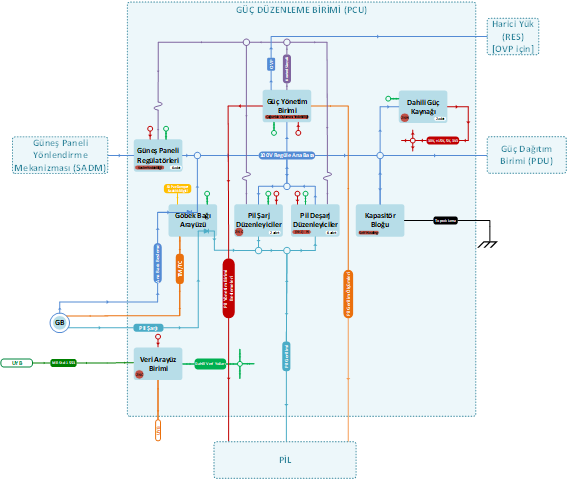
Performance
- Power output
10kW (Daylight)
9 kW (Eclipse) - Busbar voltage 100±1 V
- Efficiency : >95,9 %
- Battery type: Li-Ion
- Battery charging current: 10 A (maximum)
- Battery management Autonomous
PDU
(Power Distribution Unit)
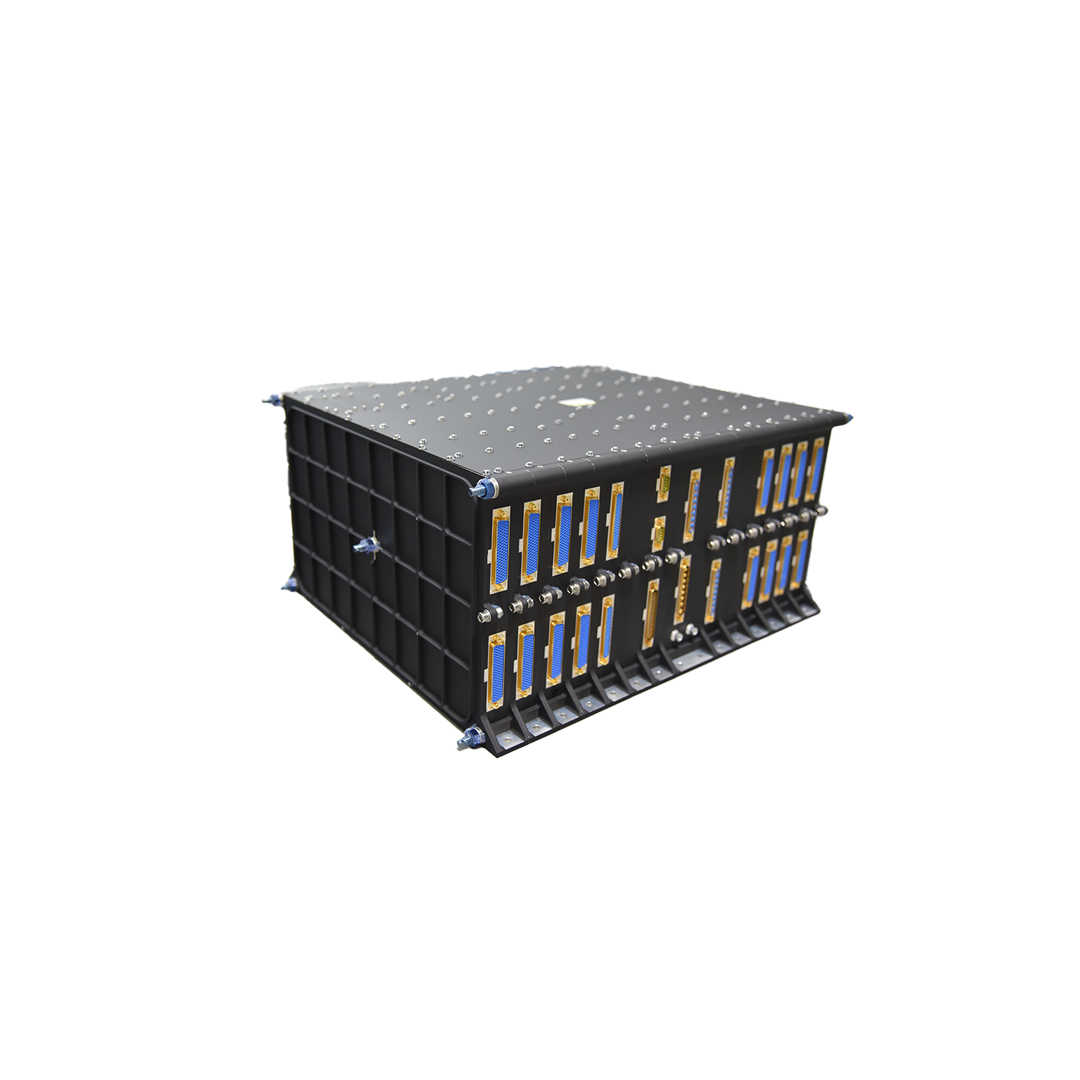
GDAB 28V - DRAWER
Power Distribution Unit 28V
Power Distribution Unit 28V is a qualified, fault tolerant and ready-to-use equipment developed by TÜBİTAK UZAY for LEO satellites within the scope of IMECE satellite. GDAB is a modular and integrated product that provides up to 2 kW power to satellite platforms and payloads. GDAB operates on 28 ±5 V unregulated main busbar. It is responsible for the distribution of power to the satellite loads, monitoring and preventing the propagation of a fault. LCL (latching current limiter) elements are used for switching and protection of loads in all satellite conditions.
Main Features
- Use of ESCC and MIL compliant materials in equipment design
- Power dissipation with stable LCLs with fast response time adjustable
- Providing power with LCL of different current protection classes (1 A to 16 A)
- Generation of voltage, current and status information TM for each satellite switch
- PWM controlled heaters (with LCL protection) provide high precision temperature regulation
- Direct connection to the primary power bus and satellite loads without any interface requirements
Budget
Weight: 20 ±0.5 kg @ 2 kW
Volume: 368 x 428 x 240 mm3 @ 2.4 kW
Power: Up to 2 kW (for 28 V unregulated main busbar)
Interfaces
Main busbar: 28 ±5 V unregulated
Data bus CAN bus and RS422
Power output Independent commandable power lines
Environmental Conditions
- Thermal: -25°C to +50°C
- Radiation LEO (for 5 years)
- EMI/EMC: MIL-STD-461
- Vibration: 20 g (sine), 10 grms (random on Z axis) and 7 grms (random on X-Y axes)
- Shock: 40 to 1,200 g (0.1 to 10 kHz)
Use in Power Subsystem Scope
GDAB consists of power distribution units (PDUs) in a configurable manner. Each distribution unit can have up to 16 LCL switches of different powers. GDAB consists of heater distribution units (IDB) in a configurable way. In each heater distribution unit, a total of 56 heater distribution switches of the same power are protected by LCL in groups of 8. Independent telemetry/telecommunication function for each power distribution and heater LCL switch is provided by CAN bus. There is also data exchange with RS422 for power distribution lines for redundancy. GDAB has an internal power supply of 5 V for internal needs and optional external needs.
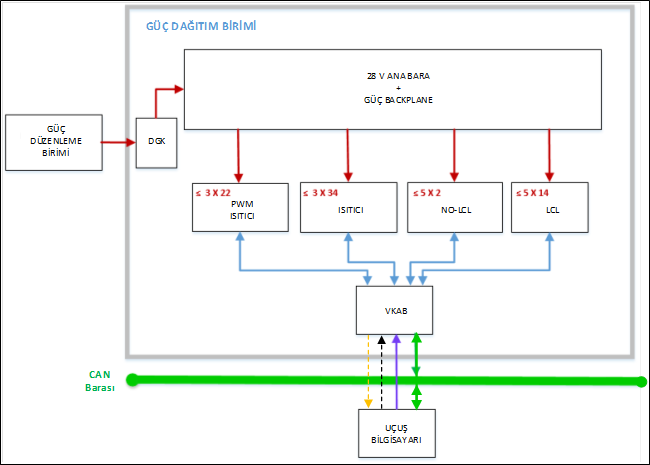
Performance
- Power output: 2 kW (for 5 GDBs and 3 IDBs)
- Busbar voltage 28 ±5 V unregulated
- Efficiency: % 98.5 (full load)
- LCL Classes:
LCL (0.5 A, 1 A, 2 A, 3 A, 4 A, 5 A, 6 A, 7 A, 8 A, 9 A, 10 A and 16 A)
Normally Open LCL (0.5 A, 1 A, 2 A and 3 A)
Heater LCL (0.5 A, 1 A, 2 A, 3 A, 4 A, 5 A and 6 A) - Number of power outputs: 80 power distribution, 168 (66 PWM) heaters
GDAB 100V - TÜRKSAT 6A
Power Distribution Unit 100V
Power Distribution Unit 100V has been developed and qualified by TÜBİTAK UZAY for GEO satellites within the scope of TÜRKSAT6A satellite as a fault tolerant unit compatible with space conditions. GDAB is responsible for distributing energy to the satellite payload and other platform units under all prescribed conditions, monitoring and preventing fault propagation. GDAB uses LCL (latching current limiter) and fuse elements to prevent fault propagation to the platform and payloads during the entire mission lifetime. It protects the loads and the main power busbar against overcurrents, provides independent switching of loads that are not fed by fuses, monitors the current information of the loads and transfers this information as telemetry.
Main Features
- Input Voltage : 100 ± 1V
- Output Distribution Voltage : 100V, 50V
- Number of Switched Heater Distribution Lines (100V) :
56 ~250W distribution lines
118 ~100W distribution lines - Number of Switched Equipment Distribution Lines (100V) :
6 ~100W distribution lines
2 ~1800W distribution lines
2 ~250W distribution lines - Number of Fuse Distribution Lines (100V) :
23 ~600W distribution lines
26 ~300W distribution lines
47 ~180W distribution lines - Number of Fuse Distribution Lines (50V) : 2 ~30W distribution lines
- Power Distribution Line Efficiency: >% 98.8
Mechanical Properties
Weight: 26.5 ± 0.5 kg
Volume: 528 mm x 428 mm x 240 mm (W x H x L)
Interfaces
Main busbar: 100±1 V
Data line: MIL 1553
Environmental Conditions
- Thermal: -25°C to +55°C
- Radiation GEO (for 15 years)
- EMI/EMC: MIL-STD-461
- Vibration/Shock: ECSS-E-ST-10-03
Use in Power Subsystem Scope
The power coming to the GDAB reaches the internal busbar in the GDAB through the capacitor block and 100V regulated power is carried to the other boards. The backplane in the GDAB carries low power signals for communication between the boards and also carries the supply voltages required for the electronic circuits of the other boards. According to the characteristics of the satellite loads, the power distribution unit has 2 types of distribution line protection methods: locked current limiter (LCL) and fuse method. The units to be switched on/off by the power distribution unit are fed and protected by the locked current limiter (LCL) method. GDAB feeds and protects loads that are in continuous transmission and open, loads with their own on/off switch at the input and loads with their own current limiting circuit at the input with fuses. GDAB also has 2 30W 50V fuse distribution lines. GDAB reads critical currents, critical voltages, critical temperature information and switch status information and transmits them via MIL-STD-1553B bus.

Performance
- Power output 10 kW
- Busbar voltage 100 ±1 V
- Efficiency: % 98.8 (full load)
- Fuse types:
100 V (1 A, 3 A and 5 A)
50 V (0.6 A) - LCL Classes:
LCL (0.5 A, 5 A, 20 A)
Heater LCL (0.5 A, 1 A, 2 A, 3 A, 4 A, 5 A and 6 A) - Number of power outputs: 166 fuse distribution, 224 heaters, 16 LCL lines (100V), 2 fuse distribution lines (50V)





